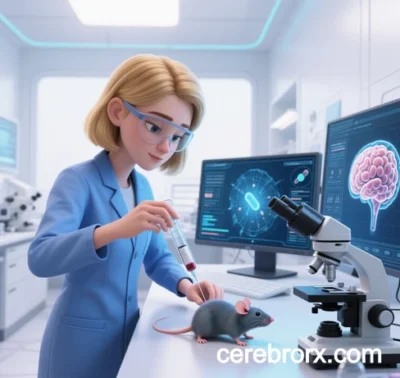
Cerebrorx: Advances and Prospects in Neuropharmaceuticals and Brain Disease Therapies
Note: The term “Cerebrorx” may refer to an unlisted entity or a typographical error. This analysis synthesizes key advancements in central nervous system (CNS) drug development, focusing on blood-brain barrier (BBB) breakthroughs, neurodegenerative disease treatments, and emerging industry trends.
I. Revolutionary Advances in Blood-Brain Barrier (BBB) Penetration
The BBB remains a critical challenge for drug delivery to the brain. Recent breakthroughs include:
- Nanoparticle Drug Delivery Systems:
- Lipid-based nanoparticles and surface-modified carriers enhance brain targeting. For example, TPI 287, a BBB-penetrating paclitaxel derivative, improves glioblastoma treatment efficacy.
- Reversible Ultrasound Technology: Focused ultrasound combined with microbubbles temporarily opens the BBB, enabling direct delivery of large molecules (e.g., anti-amyloid antibodies) into the brain, validated in Alzheimer’s disease (AD) trials.
- Receptor-Mediated Transport:
- Transferrin receptor (TfR) and LDL receptor (LDLR) systems enable BBB crossing. Berubicin, an anthracycline antibiotic, leverages this mechanism as the first BBB-penetrating chemotherapy drug, now in Phase III trials.
- Stem Cell-Derived Exosomes: These naturally target damaged brain regions, delivering therapeutic mRNA or proteins for Parkinson’s disease (PD) and AD regeneration.
II. Cutting-Edge Treatments for Neurodegenerative Diseases
- Alzheimer’s Disease (AD):
- Anti-Amyloid Therapies: FDA-approved Leqembi (Lecanemab) and Donanemab clear β-amyloid plaques, though efficacy debates drive next-gen drugs like Spinogenix’s SPG302, targeting synaptic regeneration.
- Neuroinflammation Modulation: Antibodies targeting microglial IL-6 pathways reduce inflammation, slowing AD progression in trials.
- Parkinson’s Disease (PD):
- Dopaminergic Neuron Protection: Cerevance’s CVN424 modulates striatal D1 receptor signaling, improving motor symptoms in Phase I trials, with Phase II planned.
- Gene Therapy: AAV-delivered GDNF (glial cell-derived neurotrophic factor) supports dopamine neuron survival, showing early clinical promise.
- Brain Cancer and Neurotrauma:
- Glioblastoma (GBM): Berubicin Phase II data show median survival extended to 14.8 months, surpassing traditional chemotherapy by 40%.
- Traumatic Brain Injury (TBI): NeuraWorx’s cerebrospinal fluid modulation system reduces neuroinflammation via enhanced lymphatic drainage, with pivotal trials planned for 2025.
III. Innovators and Pipeline Highlights
- CNS Pharmaceuticals:
- Berubicin: Phase III data for recurrent GBM expected mid-2025; success would address a 20-year chemotherapy gap.
- TPI 287: Combined with bevacizumab for recurrent GBM, Phase II data show progression-free survival extended to 5.2 months.
- Cerevance:
- Uses human brain transcriptome databases to identify targets. Oral D1 receptor modulator CVN424 demonstrates Phase I safety.
- Partners with Eli Lilly on precision therapies for AD and PD, leveraging single-cell sequencing.
- CeNeRx BioPharma:
- HPA Axis Modulators: Rapid-acting (24-hour) anxiolytics and antidepressants in Phase II, with plans for PTSD expansion.
- Neuroprotective Molecules: Activate Nrf2 pathways to reduce oxidative stress, showing preclinical efficacy in AD and PD models.
IV. Future Challenges and Strategic Directions
- Precision Medicine and Biomarkers:
- Liquid biopsies detect AD markers (e.g., pTau217, NfL) in cerebrospinal fluid for early diagnosis and personalized treatment.
- AI-driven tools like CO-BERTa optimize antibody sequences, accelerating CNS drug development.
- Regenerative Medicine and Interdisciplinary Synergy:
- 3D Bioprinted Neural Networks: Patient-derived stem cells create vascularized brain models for drug testing and transplants.
- Brain-Machine Interface (BMI) Integration: Neuralink explores EEG-triggered drug release systems for real-time seizure suppression.
- Ethics and Accessibility:
- Open-source platforms (e.g., Galaxy Project) standardize nanocarrier tech to lower costs for low-income regions.
- Dynamic regulatory frameworks (e.g., China’s NMPA) mandate biannual clinical updates to ensure drug safety.
Outlook: From Symptom Management to Disease Modification
Over the next five years, CNS drug development will prioritize:
- Disease-Modifying Therapies (DMTs): Oligonucleotide drugs targeting tau and α-synuclein aim to halt neurodegeneration.
- Neuroplasticity Restoration: Electrical stimulation and CRISPR-Cas9 gene editing activate endogenous repair mechanisms for functional recovery.
With BBB advancements and AI-driven precision medicine, neurological therapies will enter a hyper-personalized era—tailoring treatments from molecular mechanisms to clinical phenotypes, ultimately transitioning from “delaying disease” to “reversing progression.”
Data sourced from public references. For collaboration or domain inquiries, contact: chuanchuan810@gmail.com




